Despite a new Culdee foundation in the 8th century, which survived until the 16th, Armagh’s religious and scholarly attainments declined in the 9th – 10th centuries in the face of Danish raids and local warfare. The way was thus opened for the intrusion of lay abbots, and a powerful local family, the Clann Sinaigh, held the abbacy from 965 until 1129. One of its members, Ceallach (St Celsus), ended the abuse by having himself ordained bishop in 1106.
At the Synod of Rath Breasail, 1111, the territory assigned to each Irish see was outlined and Armagh received almost the whole territory which it now possesses i.e. nearly all of counties Armagh and Louth, about half of Tyrone, a small portion of Derry and Meath – “The See of the Archbishop of Armagh from Sliabh Breagh to Cuaille Ciannachta and from Bior to Abhainn Mhór”.
Before Ceallach’s death in 1129 he chose as his successor (St) Malachy who had to face stern opposition from Clann Sinaigh unwilling to recognise an Archbishop not belonging to their family with its traditional hereditary right to the abbacy of Armagh, and Malachy resigned his See. Gelasius (1137-74) received the pallium at the Synod of Kells, 1152. Conchubhar Mac Conchaille (1174-75) is still venerated as St Concord – the French finding his Irish name difficult to pronounce – for his sanctity at Chambery, where he died on his return journey from Rome.
The Anglo-Norman invasion brought a see-saw struggle between Irish and Anglo-Irish for possession of the See and it also prepared the way for conflicts with Dublin over the Primacy. Maolpadraig O Scanlan (1261-70) erected a larger cathedral, of which the present Church of Ireland cathedral is an 18th century re-building. Nicholas MacMaoliosa (1272-1303) was the last Archbishop of Irish race until the Reformation. Most noteworthy Norman primate was Richard Fitz-Ralph (1346-60) famous for his contests with the Mendicant Orders. The diocese was virtually partitioned into Armagh inter Hibernicos (Cos Armagh, Tyrone, and Derry) and Armagh inter Anglos (Co Louth). One of Milo Sweetman’s (1361-80) constitutions made it obligatory for all bishops to work for peace between Irish and Anglo-Irish with excommunication for any bishop who sowed discord between the two nations. The Archbishops of Armagh, both as custodians of the peace in Co Louth and as mediators among the conflicting camps, performed a vital service in the maintenance of public order on the Irish march. While they may not always have succeeded in achieving and maintaining peace, they provided a framework for Christians that bridged the gulf between the two ‘nations’. The Archbishops resided in their manors at Dromiskin and Termonfeckin and left the northern portion of the diocese to be administered by the Dean – normally of Irish race. At the Reformation, Primates George Cromer (1521) and George Dowdall (1553-58), though they strongly opposed doctrinal changes, failed to provide the intrepid leadership of their successors.
Outstanding among the Post Reformation Primates were Richard Creagh (1564-85) who spent 18 years before his death in the Tower of London; Hugh O’Reilly (1628-53) who played a prominent part in the Confederation of Kilkenny; Edmund O’Reilly (1657-69): Oliver Plunkett (1669-81) and Hugh McMahon (1714-37). The latter’s Jus Primatiale Armacanum virtually settled the long-standing dispute with Dublin over the Primacy. Archbishops Peter Lombard (1601-25) and Hugh MacCawell (1626) were distinguished scholars who spent their lives in exile. Despite the Penal Laws Armagh still had 25 Mass Houses served by 76 diocesan priests and 22 friars, in 1731.
The gradual easing of the Penal Laws in the second half of the 18th century allowed many small churches to be built. Discipline which had by now become slack was restored by Richard Reilly (1787-1818). William Crolly (1835-49) took up residence in Armagh after an absence of centuries – and began the erection of St Patrick’s Cathedral (foundation 17th March, 1840). He also built the diocesan seminary (1838) and during his time at least fifteen churches were built, some of them with Protestant support. Under Joseph Dixon (1852-66) the Diocesan Chapter was re-constituted. Daniel McGettigan (1870-87) and his two immediate successors were all translated from Raphoe. The building of the cathedral was completed and dedicated (1873) by Dr. McGettigan, who also built the Primate’s residence ‘Ara Coeli’ (1876-77). Michael Logue (1887-1924) commissioned and had completed the splendid interior decoration of the cathedral and it was consecrated in 1904. Archbishop Logue was the first occupant of the See to be made Cardinal (1893) and his successors, Patrick O’Donnell (1925), Joseph MacRory (1929), John D’Alton (1953), William Conway (1965), Tomás Ó Fiaich (1979), and Cahal B. Daly (1991) have been created Cardinals.
The 19th century witnessed a phenomenal growth in organised religious life in Ireland, and Religious played a vital role in many key areas such as education and nursing. The increase in the number of Religious Orders and Congregations here in the diocese can be seen on pp 236-237. The Vincentian Fathers conducted St Patrick’s College from 1861 to 1988 and the Nazareth Sisters were in Portadown up to the end of 1985. Tribute goes to the Mendicant Orders for their steadfastness to the Faith through dark and oppressive centuries.
The Second Vatican Council brought far-reaching changes to the Church and serves as a landmark to review its effect on us locally. In particular the “Constitution on the Sacred Liturgy” (1963) necessitated many alterations in churches, especially the redesigning of sanctuaries better suited to involve “the full conscious and active participation of all the faithful.” The newly designed Cathedral sanctuary was dedicated in June 1982. Some 19 new churches have also been erected.
Among many diocesan Post-Conciliar initiatives were the opening of Mount Oliver Pastoral Institute (1969); the Diocesan Assembly of Priests (1981), unique and historic, as never before in the history of the Irish Church had all the priests of a diocese come together to plan for future development; the Diocesan Mission to Lagos (1982); and the greater emphasis on an ecumenical thrust with the appointment of a diocesan Director of Ecumenism. A cursory glance at the contents of this directory shows the greater participation of the laity in the life and organisation of our local Church.
The events in recent years of special significance to the diocese were the canonisation of St Oliver Plunkett (1975) and the beatification of Tyrone-born Father Patrick Loughran (1992). The appointment andepiscopal ordination (1977) of the first Armachian since St Malachy brought a
sense of euphoria to us all. The sudden and dramatic circumstances of Cardinal Ó
Fiaich’s death was lamented nationwide, but especially so, here in his native
See. Not since the dedication of the Cathedral in 1873 did so many people flock
to Armagh, from home and abroad, to pay their last and loving respects to “a man
of the people,” endowed with a unique charisma for personal relationships with
people from all backgrounds and across all barriers.
After six years as 113th
Comharba Phádraig, Cardinal Cahal B. Daly announced his resignation. His sure
touch guided the Archdiocese and the Irish Church through a most troubled
period. His leadership was a bright beacon in dark days. On the feastday of St
Malachy, 1996, Dr Seán Brady, the fourth priest from the diocese of Kilmore to
do so, became the 114th Comharba Phádraig.
Diocesan Returns in 1864 show that from 1800-64 ninety-three new churches
were built and there was an increase of eighteen priests and seven religious
communities. From a Parliamentary Return of 1836 we know that Mass was still
being celebrated on Sundays and holydays “at an altar in the open air” at nine
Mass stations in the Northern end of the diocese.
Despite the limited statistics available the Table below gives some
indication of the development of the diocese over almost three
centuries.
|
No. of Orders & Congregations |
Schools |
|
| Year |
Parishes |
Other Churches |
Diocesan Priests |
Regular Clergy |
Brothers |
Nuns |
Primary |
Post Primary |
Catholic Population |
| 1704 |
46 |
– |
46 |
– |
– |
– |
– |
– |
– |
| 1731 |
– |
25 |
76 |
5 |
– |
1 |
– |
– |
– |
| 1801 |
45 |
– |
72 |
5 |
– |
– |
– |
– |
– |
| 1817 |
45 |
– |
– |
– |
– |
– |
– |
– |
– |
| 1836 |
51 |
107 |
112 |
– |
– |
– |
– |
– |
293,000 |
| 1864 |
54 |
– |
124 |
4 |
1 |
4 |
– |
– |
– |
| 1964 |
55 |
159 |
186 |
9 |
4 |
14 |
229 |
16 |
144,000 |
| 1999 |
61 |
151 |
154 |
8 |
4 |
13 |
168 |
29 |
205,532 |
The publication of Archdiocese of Armagh – A History has placed the
Archdiocese under a huge debt of gratitude to the author, Monsignor Réamonn Ó
Muirí. This superbly produced volume is a charming narration of the rich
heritage of the ancient See of Patrick. It tells in summary but scholarly
fashion of the steadfast loyalty of pobal Dé of the Archdiocese down the ages
since the advent of Christianity here even though their hearts were darkened by
crisis and tragedy.
For
three days Ireland rejoiced as never before during the visit of Pope John Paul
II to our native land. Those who were privileged to be present on that memorable
Saturday in September, 1979, can recall their sheer joy and exhilaration, as the
helicopter carrying His Holiness, landed at Drogheda. This brief outline is
concluded with the words of the Pope’s address on that occasion: “Faith and
fidelity are the marks of the Church in Ireland: a Church of martyrs, a Church
of witnesses, a Church of heroic faith, heroic fidelity. These are the
historical signs marking the track of faith on Irish soil. The Gospel and the
Church have struck deep roots in the soul of the Irish people. The See of
Armagh, the See of Patrick, is the place to see that track, to feel these
roots”.
Updated November 2000 Dermot McDermott, CFC
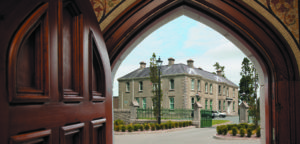
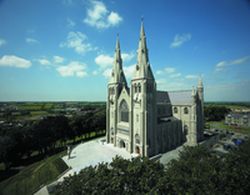
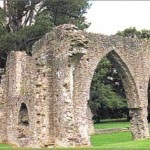
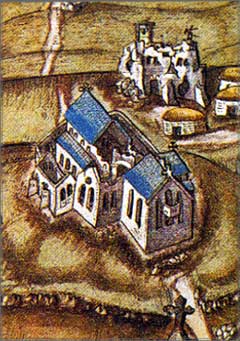
You must be logged in to post a comment.